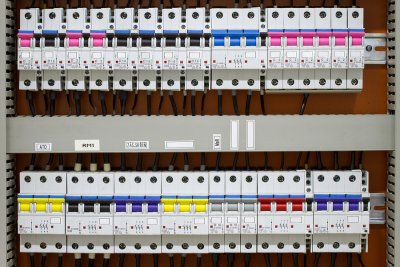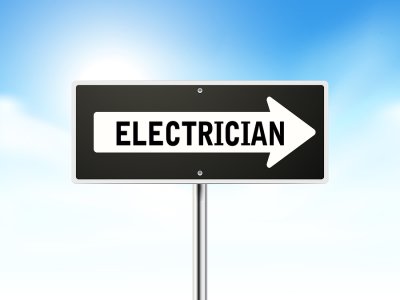-
What Is Knob-and-Tube Wiring?
As a homeowner, you likely take great pride in tackling home improvement projects yourself. However, there are some things that are worth calling a professional for: electrical wiring , for example. If your home was built before World War II, there’s a chance that it was wired with the knob-and-tube method. This wiring method is now obsolete, and should be replaced wherever it exists.
As the name suggests, knob-and-tube wiring is comprised of ceramic knobs and tubes. Unfortunately for the owners of older homes, knob-and-tube wiring is difficult to improve or retrofit, and is considered a fire hazard—especially when the wires are surrounded by building insulation. This is because the fiber materials in knob-and-tube wiring can become brittle over time. If your home has this type of wiring, it’s possible that your insurance company will not approve fire insurance. For the sake of your own safety, it’s important to have an electrician identify and remove knob-and-tube wiring and replace it with a safer method of wiring as soon as possible.

-
What to Know About Arc Fault Breakers
Since most of a typical home’s electrical system is out of sight, most homeowners do not understand how complex or sophisticated it truly is. For example, one big aspect of the modern home electrical system is the arc fault breaker, also known as an arc fault circuit interrupter. This piece of technology is vital for protecting your home from electrical fires.

Importance
To understand the importance of arc fault breakers, it’s important to understand the concept of arc faults. Simply put, an arc fault is when an arc, or electrical discharge, flows through an unplanned path. As you can imagine, this could lead to some pretty dangerous circumstances—including an electrical fire. An arc fault breaker is designed to detect arc faults and protect the circuit, thereby reducing the risk of an electrical fire, of which there are more than 40,000 a year in the U.S.
Basic Function
The average arc fault breaker is very sophisticated, and uses advanced technology to detect various types of arcing. Normal arcing occurs all the time when electrical appliances are turned on—these require no special action from the arc fault breaker. When an arc fault occurs, however, the arc fault breaker instantly recognizes the fault and interrupts the circuit, thereby reducing the danger. By contrast, conventional circuit breakers are only equipped to respond to overloads and short circuits. Arc fault breakers are now required by law for circuits feeding into electrical outlets in most rooms.
Nuisance Tripping
Though arc fault breakers are vital for safety, there are times when they overreact. In other words, an arc fault breaker may interrupt a circuit even when an appliance is being used safely and properly. This is called “nuisance tripping.” This occurs most commonly with older electrical tools and appliances that have motors with brushes. Vacuums and power drills are two such appliances. If your breaker frequently engages in nuisance tripping, have an electrician take a look and address the problem. You should know that arc fault breakers are being improved on all the time.
-
How to Reset a GFCI Outlet
Most homeowners know very little about their electrical system. While you don’t need to be a professional electrician to be a responsible homeowner, it helps to know a few basic things. For example, it’s good to know that a GFCI outlet, or ground-fault circuit interrupter outlet, can be reset when it trips. This video provides a good introduction to GFCI outlets as well as a simple demonstration of how to reset a tripped outlet.
GFCI outlets are designed to automatically trip under potentially dangerous circumstances—for instance, when a blow dryer is dropped into a tub. When this occurs, the reset button (the top button) is in while the test button is out. To reset the outlet, simply press the reset button and power should be restored to the outlet. If it isn’t, you should call a San Jose electrician.
-
Tips for Choosing an Electrician
Your home is probably one of your favorite places on Earth. As such, you wouldn’t trust its care and maintenance with just anybody. However, there are certain maintenance and home improvement jobs that are too dangerous and important to attempt yourself. When it comes to electrical wiring, for example, you’re best off turning to a trusted San Jose electrician . For help finding the right electrician for your needs, consider the following tips.

Determine What You Need Done
Before you start your search, you should determine exactly what you expect from your technician and jot down a few questions about the proposed project. Are you looking for a routine inspection, or do you have a more specific job in mind? Do you need an electrician to provide wiring for a new building, or do you need to rewire an existing structure? This is important because different electricians have different specialties.
Look at Qualifications
Once you’ve narrowed down your search somewhat, look at the remaining candidates’ credentials and qualifications. Make sure you choose an electrician that is fully licensed, insured, and bonded in the State of California. It’s also a good idea to check the license number of each electrical contractor, just to make sure it’s safe and legal for them to work on your project.
Check Out Past Reviews
Now’s the time to check out past reviews for the electrician you’re interested in hiring. If you see an electrician with a high rating on Yelp!, Google Reviews, and other review services, then you may have found your team. If an electrician has performed well for numerous past clients, then there’s a good chance that they’ll perform well for you, too.
Conduct a Brief Interview
Once you think you’ve found a suitable electrician, don’t be afraid to call them up. Ask whatever questions come to mind, discuss your proposed project, and get a feel for how the electrician conducts business. If you have a good feeling, and the credentials and reviews check out, odds are you’ve found your electrician.
RECENT POSTS
categories
- Uncategorized
- Delta Electric
- Commercial Electrical
- Residential Electrical
- Electric Circuits
- Dedicated Circuits
- Circuit Breakers
- Electrical Panels
- Electrical Wiring
- Safety Inspections
- copper wires
- Electrician San Jose
- Trained Electricians
- Electrical Services San Jose
- Malfunctioning Electrical Outlets
- Circuit Breaker
- Grounding
- safety
- Flickering Lights
- Arc Fault Breakers
- electrical system
- Aluminum Wiring
- Circuit Interrupters
- House Surge Protection
- Zinsco Panel Warnings
- Wiring Conversion
- GFCI outlet
- professional electrician
- Knob-and-Tube Wiring
- modern home electrical system
- Fuses
Archives
2025
2024
2023
2018
2017
- December (4)
- November (4)
- October (5)
- September (4)
- August (4)
- July (4)
- June (4)
- May (4)
- April (4)
- March (3)
- February (4)
- January (3)
2016
- December (3)
- November (4)
- October (4)
- September (4)
- August (4)
- July (4)
- June (4)
- May (4)
- April (4)
- March (4)
- February (4)
- January (4)
2015
- December (4)
- November (4)
- October (4)
- September (4)
- August (3)
- July (4)
- June (4)
- May (3)
- April (4)
- March (4)
- February (2)
2014
- December (3)
- November (4)
- October (4)
- September (6)
- August (2)
- July (3)
- May (2)
- April (1)
- March (2)
- February (1)
- January (1)

